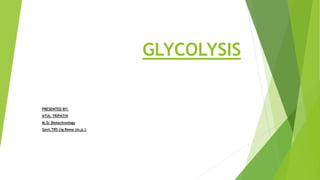
Glycolysis: How Cells Break Down Glucose
- 1. GLYCOLYSIS PRESENTED BY: ATUL TRIPATHI M.Sc Biotechnology Govt.TRS clg Rewa (m.p.)
- 2. METABOLISM Metabolism is a series of inter connected chemical reaction occuring within a cell and the chemical compounds involved in it are termed as metabolities. Metabolism is the process by which your body converts what you eat and drink into energy. In this process glycolysis is the part of it.
- 3. GLYCOLYSIS Glycolysis comes from a merger of two greek word:Glysks-sweet Lysis-breakdown It is also known as EMBDEN MEYERHOF-PARNAS. DEFINITION: Glycolusis is defined as the sequence of reaction converting glucose to pyruvate Or lactate, with production of ATP(Adinosine-tri-Phoaphate). -
- 4. Features of glycolysis: Glycolysis has several important features: 1. It breaks down one molecule of glucose, a 6-carbon molecule, into two molecules of pyruvate, a 3-carbon molecule, in a controlled manner by ten or more reactions. The oxidation of glucose is controlled so that the energy in this molecule can be used to manufacture other high energy com 2. It makes a small amount of ATP, a process known as substrate-level phosphorylation. For each glucose molecule that is broken down by glycolysis, there is a net gain of two molecules of ATP. 3. It makes NADH (reduced nicotinamide adenine dinucleotide), a high energy molecule which can be used to make ATP in the electron transfer chain (see below). For each glucose molecule that is broken down by glycolysis, there is a net gain of two molecules of NADH. 4. It makes compounds which can be used to synthesize fatty acids. In particular, some of the carbohydrate intermediates of glycolysis are used by other enzymatic reactions to synthesize fatty acids, the major constituents of lipids, important energy storage molecules.
- 5. Reaction of glycolysis The breakdown of glucose to 2 moleculeas of pyruvate is brought about by sequence of 10 reactions which is divided into 2 phase: 1. Preparatory phase 2. Payoff phase PREPARATORY PHASE: 1. It consists of the 1st 5 step of glycolysis in which the glucose is enzymatically phosphorylated by ATP to yeild Fructose-1, 6 biphosphate. 2. This fructose-1, 6, biphosphate is then split in half to yeild 2 molecules of 3 carbon containing glyceraldehyde-3, phosphate/dihydroxy-acetone-phosphate. Thus the first phase results in cleavage of hexose chain, this cleavage requires an investment of 2 ATP molecules to activate the glucose mole and prepare it for its cleavage into 3-carbon compound.
- 7. Payoff phase: 1. This phase constitutea the last 5 reaction of glycolysis. 2. Thsi phase makes the release of ATP molecules during conversrion of glyceraldehyde-3-phosphate to 2 moles of pyruvate. 3. Here 4 molese of ADP are phosphorylated to ATP. Although 4 moles of ATP are formed, the net result is only 2 moles of ATP/moles of ATP are utilized in phase 1.
- 9. Stepwise explanation: Step 1 The enzyme hexokinase phosphorylates or adds a phosphate group to glucose in a cell's cytoplasm. In the process, a phosphate group from ATP is transferred to glucose producing glucose 6-phosphate or G6P. One molecule of ATP is consumed during this phase. Step 2 The enzyme phosphoglucomutase isomerizes G6P into its isomer fructose 6-phosphate or F6P. Isomers have the same molecular formula as each other but different atomic arrangements. Step 3 The kinase phosphofructokinase uses another ATP molecule to transfer a phosphate group to F6P in order to form fructose 1,6-bisphosphate or FBP. Two ATP molecules have been used so far. Step 4 The enzyme aldolase splits fructose 1,6-bisphosphate into a ketone and an aldehyde molecule. These sugars, dihydroxyacetone phosphate (DHAP) and glyceraldehyde 3-phosphate (GAP), are isomers of each other. Step 5 The enzyme triose-phosphate isomerase rapidly converts DHAP into GAP (these isomers can inter- convert). GAP is the substrate needed for the next step of glycolysis.
- 10. • Step 6 The enzyme glyceraldehyde 3-phosphate dehydrogenase (GAPDH) serves two functions in this reaction. First, it dehydrogenates GAP by transferring one of its hydrogen (H⁺) molecules to the oxidizing agent nicotinamide adenine dinucleotide (NAD⁺) to form NADH + H⁺. Next, GAPDH adds a phosphate from the cytosol to the oxidized GAP to form 1,3- bisphosphoglycerate (BPG). Both molecules of GAP produced in the previous step undergo this process of dehydrogenation and phosphorylation. • Step 7 The enzyme phosphoglycerokinase transfers a phosphate from BPG to a molecule of ADP to form ATP. This happens to each molecule of BPG. This reaction yields two 3-phosphoglycerate (3 PGA) molecules and two ATP molecules. • Step 8 The enzyme phosphoglyceromutase relocates the P of the two 3 PGA molecules from the third to the second carbon to form two 2-phosphoglycerate (2 PGA) molecules. • Step 9 The enzyme enolase removes a molecule of water from 2-phosphoglycerate to form phosphoenolpyruvate (PEP). This happens for each molecule of 2 PGA from Step 8. • Step 10 The enzyme pyruvate kinase transfers a P from PEP to ADP to form pyruvate and ATP. This happens for each molecule of PEP. This reaction yields two molecules of pyruvate and two ATP molecules.